|
BULB LOG 01 --- 3rd January 2007
Hogmanay night was very wet and stormy but it all cleared up before midnight allowing the festivities in Aberdeen to take place. Tens of thousands of enthusiastic revellers took advantage of the weather window and ceillidhed to a live concert in the main street, appropriately the main band was Wet Wet Wet. Lets hope the clear weather at the 'Bells' was a good omen for the year.

Muscari seedling
Another good sign for the New Year and despite the freezing conditions that we have had for the last week or two seeds are germinating in the bulb houses. These Muscari seedlings are interlopers as they are germinating in a pot of Fritillarias which were not repotted last summer. The pot of the Muscari was next to the frit pot and I obviously did not collect all the seed quickly enough as some was shed into neighbouring pots. As we grow very few Muscari in the bulb house this is not a big problem and it will be easy for me to separate out the muscari bulbs from the frits when I next repot them. However this must act as a lesson to me to act quicker and not allow the seeds in the bulb house to shed into adjacent pots as it can lead to a serious mix up of our collections. When we grew fewer bulbs in pots and managed to repot them all every year stray seeds like these were not a problem as they were spread into the garden with the used potting compost. However now we have so many pots and do not have the time to
repot them all every year I will have to take more care to prevent these stray seeds.
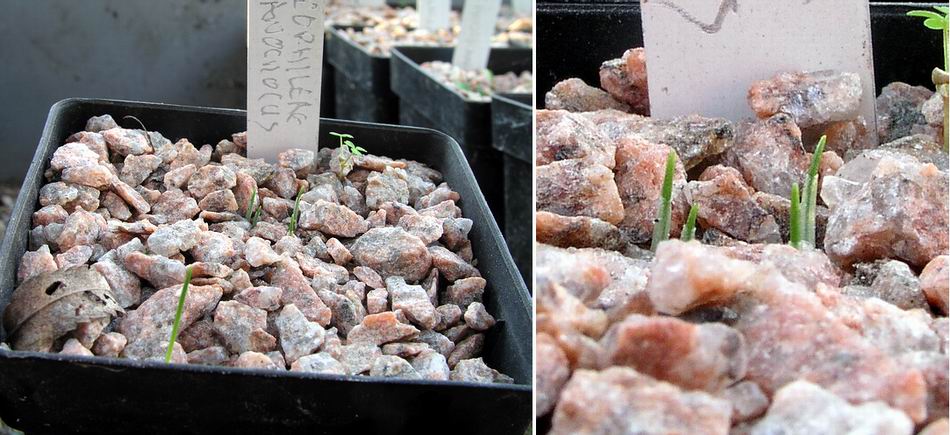
Tecophilaea cyanacrocus seedlings
Also germinating now are these Tecophilaea cyanacrocus seedlings. I find that, provided they were sown at the optimum time, most bulbs seeds start to germinate at the same time as mature bulbs start to show signs of growth and I showed you the shoots of Tecophilaeas just poking through the gravel a few logs back. If you get Tecophilaea seeds from the seed exchanges and cannot sow them until they arrive in January or February then they may take a year before they are enticed out of dormancy.
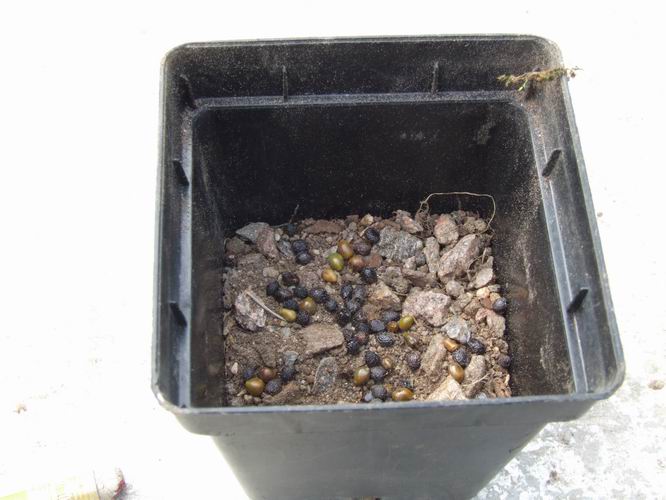
Tecophilaea cyanacrocus seeds
Just to remind you that I sowed these seeds back in September at depth at least half way down the pot. You can see that their first leaves have easily made their way up to the surface and the big advantage is that their young bulbs will be in a more stable environment than they would be if they were sown on the surface and only covered with a layer of gravel.
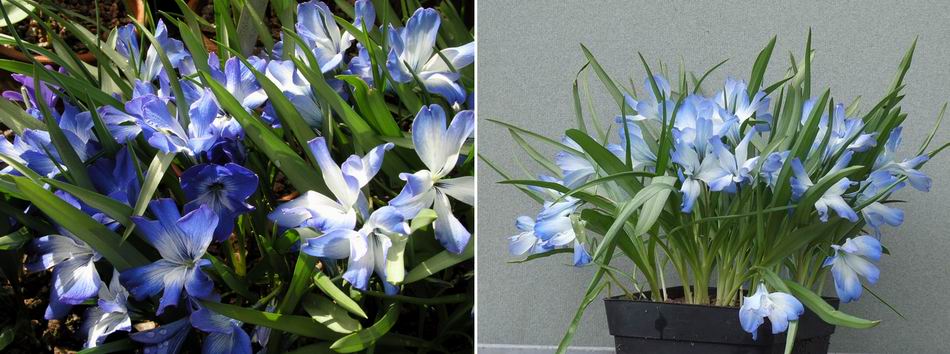
Tecophilaea cyanacrocus
To add some colour to this mid winter log here is a reminder of the parent bulbs flowering last March/April. Notice the wide variation in the amount of blue to white that you can get when you raise them from seed.
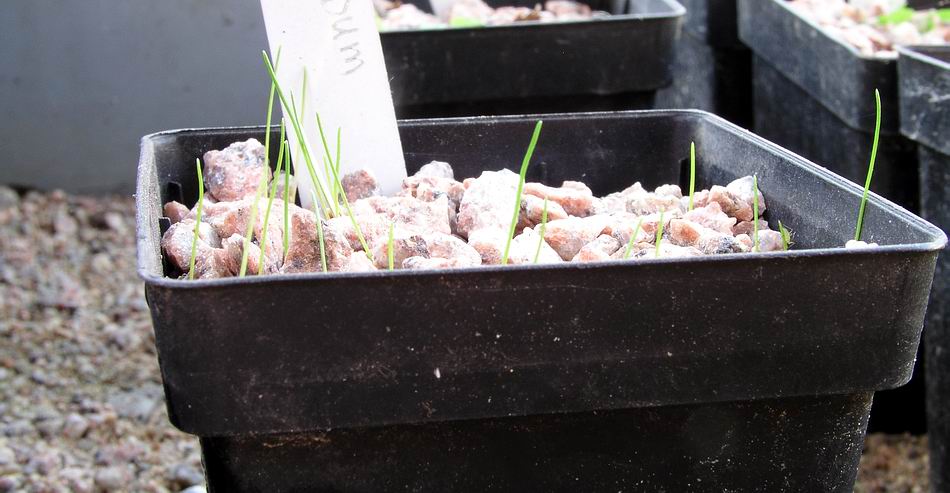
Northoscardum ostenii
Another Southern Hemisphere bulb from South America also has seeds germinating now. I sowed the seeds that we collected from our pot of Northoscardum ostenii
on the surface, only covering them with about 1-2cms of gravel and they too are germinating well. So why did I sow them on the surface and not at depth? Not all bulb seeds will germinate if buried, some may have a light requirement to stimulate germination but all will germinate if surface sown - the trick is to work out which are which. My initial guide is to work out the seed dispersal mechanism that the plant has evolved - the Tecophilaea seeds have elaiosomes, a sugary attachment that invites ants to take them under ground while the Northoscardum ostenii does not. Most seeds that have evolved to be taken underground by ants have also evolved so the new bulb forms close to the seed while those that have a surface distribution mostly send down a stolon or root and the new bulb forms towards the bottom of this growth. If I am in any doubt then I surface sow the seeds and when they germinate I carefully lift some gravel to see whether the bulb is forming beside the seed or if it has disappeared down into the
compost.
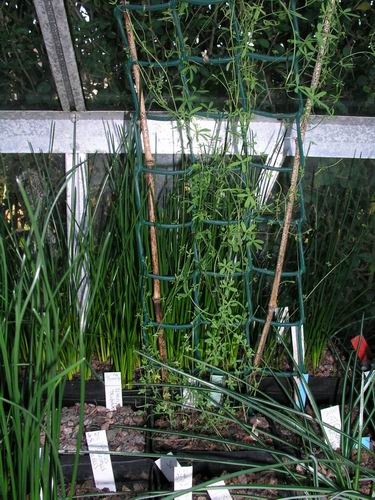
Tropaeolum azureum seedlings
The smaller Tropaeolum azureum seedling corms from last year have all made good growth and should flower this spring. I am pleased to see this growth as I distributed some of the larger seedling corms from this germination to other growers last summer so they should all have flowering plants as well.

Northoscardum ostenii and Tropaeolum azureum
Just to remind you of what they look like.

Remove bracts
There is always plenty to do in the bulb house through the winter especially as the temperature has risen and the threat of wet rots attacking the bulbs is ever present. It is extremely important that you remove the fading flowers and any shrivelling bract material from the crocus plants as this will attract botrytis and other rots that will destroy the leaves and the corms if you do not control it by cleaning up your plants.

Colchicum leaves with rot
I did pluck the flowers off these colchicums when they faded but I did not manage to get them out cleanly. A part of the tube remained underground in between the leaves which have now started to rot and this is spreading to the new leaves. I have carefully tried to remove all the infected material and will let this pot get quite dry allowing it to draw moisture from the moist sand of the plunge only.

Mould forming on narcissus
Vigilance is also required with fading narcissus flowers that are also mildewed and need removing.
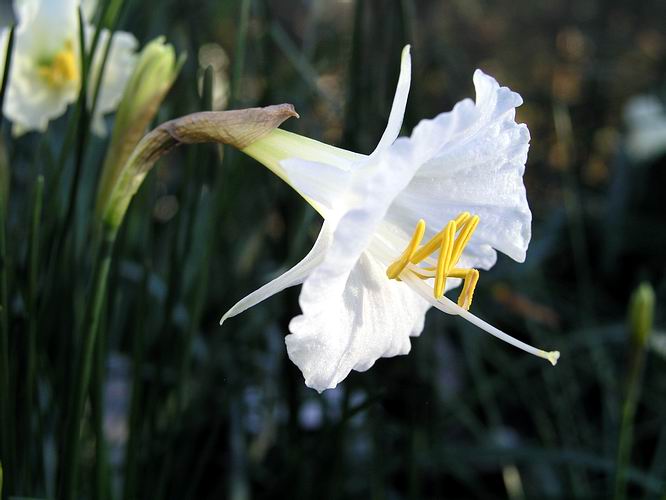
Narcissus seedling
More narcissus flowers are opening every time we get a bright day and I like the shape of this nice white seedling which is almost certainly a hybrid between Narcissus cantabricus and romieuxii which are both very promiscuous in our bulb houses.
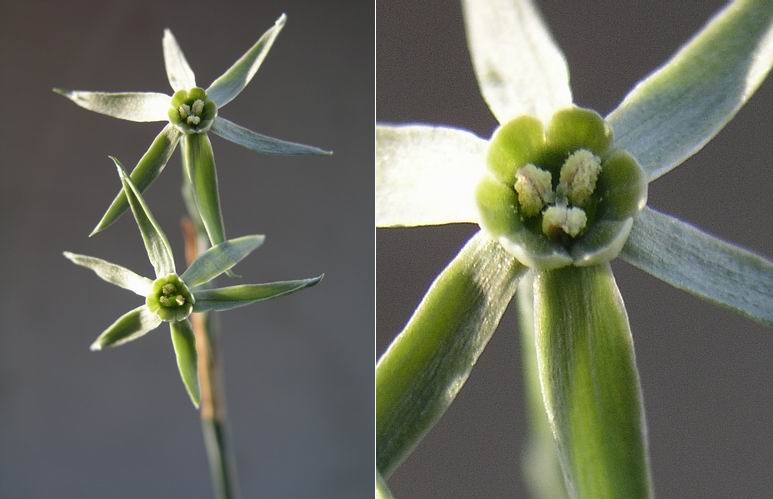
Narcissus viridiflorus
The bizarre flowers of Narcissus viridiflorus are still fresh and the pollen is good so I will be out with my paint brush to both self fertilise them and try and see if I can have any success at crossing it to some of the other narcissus that are in flower just now.
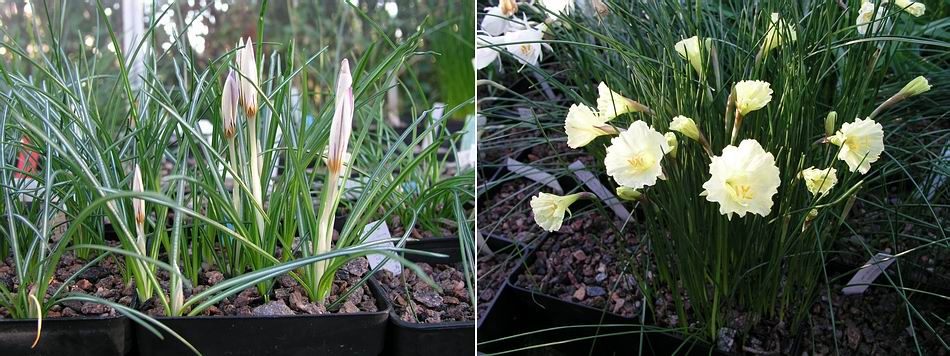
Crocus and Narcissus to come
There are many promising signs of a good flowering season to come from the bulbs if the weather will be kind to us and stay cold for a few months to hold them back until the days lengthen again.
^ back to the top ^
|

